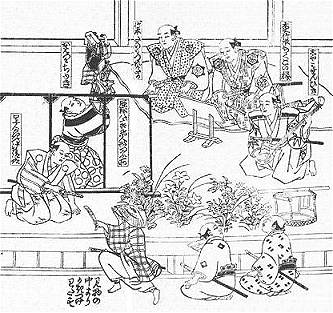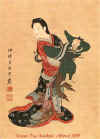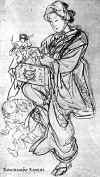

Sonezaki Shinju - click for full image (55k)
For The Appreciation of
Bunraku
Here is a short essay written by Taru Saito, a member of the
Foundation Modern Puppet Center of Japan. I thought you might like to hear about the art
from an actual insider. For the Appreciation of Bunraku.
More Interesting Facts
 As Saito-san explained, three puppeteers
control a single puppet. They are: As Saito-san explained, three puppeteers
control a single puppet. They are:
Omo-zukai: head puppeteer, often a Master, who controls the head and right arm.
This man usually appears unhooded. Hidari-zukai: second puppeteer, operates the
left hand. He is also responsible for props.
Ashi-zukai: third puppeteer, the Junior, works the legs and feet. Male puppets
have metal heel grips. Females do not have legs, so the puppeteer must pinch the inner
part of the kimono.
 Minor characters (soldiers, servants, hand-maidens) are simple puppets
requiring only one puppeteer. Minor characters (soldiers, servants, hand-maidens) are simple puppets
requiring only one puppeteer.
 Puppeteers are usually hooded and wear black. They appear in full view of
the audience. Puppeteers are usually hooded and wear black. They appear in full view of
the audience.
 Furi: Realistic human movements (such as crying, dancing,
running, or smoking) reproduced by the puppets. Furi: Realistic human movements (such as crying, dancing,
running, or smoking) reproduced by the puppets.
 Kata: Stylized poses and gestures used for dramatic moments.
Female kata is less dramatic. Kata: Stylized poses and gestures used for dramatic moments.
Female kata is less dramatic.
 Urakata: "people of backstage," such as wig master,
repairer of heads, or the costume director Urakata: "people of backstage," such as wig master,
repairer of heads, or the costume director
 Takemoto Gidayu: Founded his puppet theatre in 1684 in Osaka.
Since, his name has become synonymous with the narration style used for puppet
performances. Takemoto Gidayu: Founded his puppet theatre in 1684 in Osaka.
Since, his name has become synonymous with the narration style used for puppet
performances.
 Tatsumatsu Hachirobei: Famed Master Puppeteer to helped bring the
puppet theatre to its peak in the early eighteenth century. Tatsumatsu Hachirobei: Famed Master Puppeteer to helped bring the
puppet theatre to its peak in the early eighteenth century.
 Chikamatsu Monzaemon: A former writer for Kabuki theatre, he
chose to begin writing solely for puppet plays, as he felt that puppets could portray the
emotion and meanings better than humans. He wrote over one hundred plays for Bunraku. Chikamatsu Monzaemon: A former writer for Kabuki theatre, he
chose to begin writing solely for puppet plays, as he felt that puppets could portray the
emotion and meanings better than humans. He wrote over one hundred plays for Bunraku.
 By 1733, puppets had a wide range of movements, such as the mouths, eyes,
and fingers. By 1733, puppets had a wide range of movements, such as the mouths, eyes,
and fingers.
 Female puppets have mouth pins, so that in moments of sorrow, they can
touch the sleeve of their kimono to their lips without it falling. Female puppets have mouth pins, so that in moments of sorrow, they can
touch the sleeve of their kimono to their lips without it falling.
 Today, many forms of puppetry can be found in Japan. The Japan Puppetry Atlas has links to
many theatres' sites. I personally recommend you visit Miniature Theatre Aotent in Kanta.
It's beyond kawaii! Today, many forms of puppetry can be found in Japan. The Japan Puppetry Atlas has links to
many theatres' sites. I personally recommend you visit Miniature Theatre Aotent in Kanta.
It's beyond kawaii!
 Want to see a little Bunraku, but can't get to Japan? Rent the Marlon
Brando film "Sayonara." About 3/4 of the way through the film, Brando and three
others see a Bunraku play ("Sonezaki Shinju"). The scene isn't very long, but
it's better than nothing! >^-^< As a neat little bonus, the actress who explains the
play's plot to the Americans is none other than Miyoshi Umeki ("Mei Li" from the
Rogers & Hammerstein musical "Flower Drum Song"). Want to see a little Bunraku, but can't get to Japan? Rent the Marlon
Brando film "Sayonara." About 3/4 of the way through the film, Brando and three
others see a Bunraku play ("Sonezaki Shinju"). The scene isn't very long, but
it's better than nothing! >^-^< As a neat little bonus, the actress who explains the
play's plot to the Americans is none other than Miyoshi Umeki ("Mei Li" from the
Rogers & Hammerstein musical "Flower Drum Song").
 Recommended reading: Recommended reading:
Backstage at Bunraku --written by Barbara C. Adachi with photos by Joel Sackett /
ISBN 0-8348-0199-X Weatherhill Publishing, New York and Tokyo (Portions of this book were
published by Kodansha International, Ltd. under the title "The Voices and Hands of
Bunraku")
No and Bunraku: Two Forms of Japanese Theatre --written by Donald Keene with
photos by Kaneko Keizou/ ISBN 0-231-07419-0 Columbia University Press, New York
 Recommended Link: The
Bunraku Recommended Link: The
Bunraku
Bunraku in Ayatsuri Sakon
 Technically, most of Ukon's movements are
impossible for Sakon to be controlling them with only one hand. This has lead a couple
articles to refer to Ukon as being a "Haunted Puppet" with the ability to move
on his own. Some scenes do show Ukon talking and moving whilst Sakon is asleep or
otherwise engaged, but he never moves by himself when he and Sakon are apart. However, the
authors were very kind to include scenes of traditional performance. Sakon appears in
these scenes dressed as a true Master, unhooded and in fine robes. He also uses both
hands. Often he confronts villians through these performances. Technically, most of Ukon's movements are
impossible for Sakon to be controlling them with only one hand. This has lead a couple
articles to refer to Ukon as being a "Haunted Puppet" with the ability to move
on his own. Some scenes do show Ukon talking and moving whilst Sakon is asleep or
otherwise engaged, but he never moves by himself when he and Sakon are apart. However, the
authors were very kind to include scenes of traditional performance. Sakon appears in
these scenes dressed as a true Master, unhooded and in fine robes. He also uses both
hands. Often he confronts villians through these performances.
 Women in the traditional Bunraku theatre were usually background people,
rarely builders or performers. Today, they have mush more freedom to perform, especially
in local theatres and school clubs. This is perhaps why Haruka, the female puppet-builder
in Book Four, isn't very confident about her craft. Nor does she ever really receive
recognition for her work. Women in the traditional Bunraku theatre were usually background people,
rarely builders or performers. Today, they have mush more freedom to perform, especially
in local theatres and school clubs. This is perhaps why Haruka, the female puppet-builder
in Book Four, isn't very confident about her craft. Nor does she ever really receive
recognition for her work.
 Sakon's ability as a ventriloquist is actually not a required part of
Bunraku. Traditionally, all voices are provided by the Tayu (narrator) as the puppeteers
focus on movement and performance. However, his talent comes in very handy now and again. Sakon's ability as a ventriloquist is actually not a required part of
Bunraku. Traditionally, all voices are provided by the Tayu (narrator) as the puppeteers
focus on movement and performance. However, his talent comes in very handy now and again.
 The puppetry styled used by Sakon actually dates back to the earliest
forms of this art in Japan, long before Bunraku had moved to the forefront. This
type of performance was done by a priest who used the puppet to channel the spirits or
capture the bad spirits inhabiting a village and remove them. They also used the
puppets to tell about various gods, Ebisu (patron god of puppetry in Japan) being
particularly popular. These performers were called "mawashi." The puppetry styled used by Sakon actually dates back to the earliest
forms of this art in Japan, long before Bunraku had moved to the forefront. This
type of performance was done by a priest who used the puppet to channel the spirits or
capture the bad spirits inhabiting a village and remove them. They also used the
puppets to tell about various gods, Ebisu (patron god of puppetry in Japan) being
particularly popular. These performers were called "mawashi."
Otome
Bunraku
Otome Bunraku (translated to Women's Bunraku) has been
experiencing a revival in Japan since the early 1990's. It is difficult to find much
information on the history of this puppeteering style. The earliest I have been able
to find official mention of it is 1925. However, this painting of a female
puppeteer is dated in the 1800's (Figure 2 at right). For the most part, Otome
Bunraku is made up of women puppeteers and puppet builders. Instead of using the
three-man system commonly found in Bunraku, this style focuses on one person per puppet.
The puppet is fixed to the performer's body (probably in the torso region) with
wires attaching the puppet's head to that of its operator. Two wires, one on each
side of the head, connect to a rig worn like a hat of sorts by the performer. Any
head motion made by the puppeteer is perfectly translated into the puppet. The hands
of the puppet are either articulated, or the puppeteer will just substitute her own hands
into the puppet's sleeves. A wonderful Otome Bunraku troupe (pictured) recently graced the
2000 Henson
Puppetry Festival in New York. Men have also taken to the one-person style, using
the head brace and movement techniques in their individual performances.
Otome Bunraku Links:
Manami Sakamoto - a modern
puppeteer
Otome Bunraku Theater (three
avi files of a performer)
Yoshida Mitsuka: Otome Bunraku (mostly
in Japanese with some English-lots of pictures)
|

Fig 1. click for full image (26k) |

Fig 2. Painting from the 1800's.
click for full image (78k) |

Fig 3. click for full image (87k) |
|




